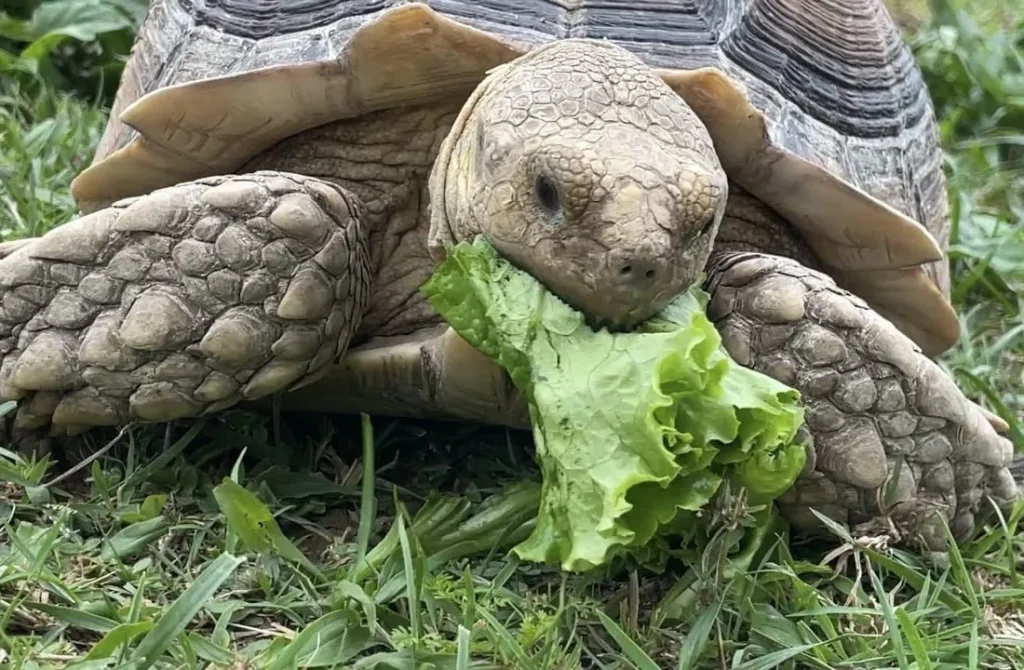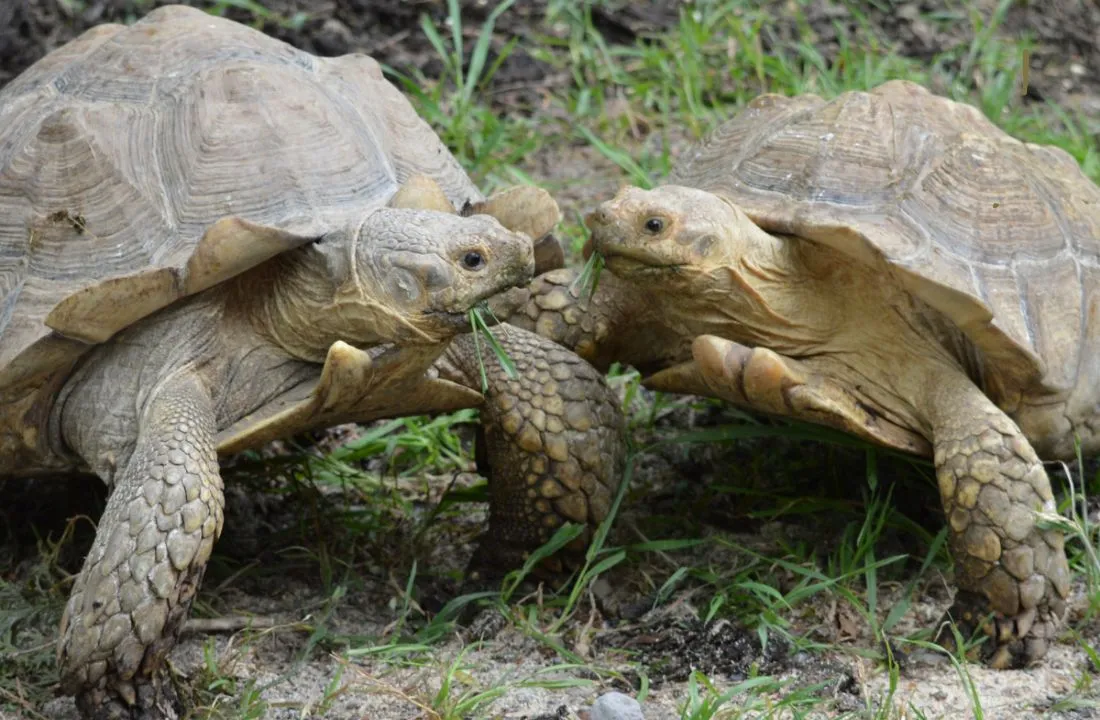Sulcata Tortoise Care Guide
The Sulcata tortoises are found in Africa and are the third largest in the world. Its scientific name is Centrochelys sulcata. Its popularity is due to its size. On hot days, they mostly stay underground to escape the heat. A special thing about them is that it is a cold-blooded creature.
For More Information About Reptiles Click Here
Physical Description:
- Adults grow to 24 to 32 inches in length and their weight becomes 70 to 140 pounds sometimes reaching near about 190.
- The baby turtles are about three to four inches in size
- The shell is oval and has a sandy or golden brown colour prominent.
- Their skin is thick and strong. Their yellowish-brown skin provides them protection against the sun.
- The head is broad and has a beak-like mouth, while the tail is small and pointed.
- Males are generally larger with their bottom shell curved inwards and longer tails compared to females.
Price of Sulcata Tortoise:
- Baby: $50 to $200 (under one year)
- Juvenile: $149 to $510 (one to 3 years)
- Adult: $510 to $2000plus (over 3 years)
what do feed for Sulcata Tortoise:
As you know sulcata tortoises mostly depend on plants, they are also called herbivores. Just like other living things need food, the sulcata tortoise also needs food and cannot live without food. The diet consists mostly of green leaves, plants, herbs, etc. Food helps them live longer and stay healthy.
Food List:
- The main diet of this tortoise is dry fodder and grass which keeps it healthy.
- Weeds and flowers (clover, plantain weeds, daisy flowers, rose petals).
- Leafy greens (Mustard leaves, Turnip leaves).
- vegetables( pumpkins and bell peppers).

Pyramiding of Sulcata Tortoise:
Pyramids are a disease due to which the growth of the tortoises stops and they start to become weak. The disease causes the hard shell there to begin to grow, become uneven, and take on a pyramidal shape. Most of these diseases of pyramids are caused by the lack of proper and fresh food for the tortoise.
Causes:
A deficiency of humidity is a major cause of pyramids in tortoises. They are naturally found to lay eggs only during the rainy season. They love humidity so they lay eggs during the rainy season. If sulcata tortoises are not properly fed a diet that is low in fiber and high in protein, such a diet can lead to pyramid disease.
Sunlight is very important for them, it provides them with vitamin D3. If they do not get sunlight, they will face a deficiency of calcium and their shells will become soft.
Factors that are Necessary for Sulcata Tortoise:
Food:
If the sulcata tortoise is not fed, it becomes weak, so food is very important. Its favorite food is vegetables, leaves, herbs, etc. Fresh food keeps them healthy and strong.
Water:
Water is very important for turtles as they are used to living in a dry environment. They need more hydration which requires fresh water and is very important for their digestive system.
Humidity:
Sulcata tortoises require humidity which helps to grow them. Otherwise, they suffer from various diseases. Some lay most of the eggs when it is the rainy season when the moisture deficiency is completely fulfilled for them. They need 60 to 70 percent humidity.
Heat:
Tortoises should be heated according to the weather, they like to live in warm areas. It easily tolerates temperatures of 50 to 60 degrees Celsius.
Temperament:
These turtles also behave like dogs, just as a dog is loyal and friendly to its owner, it also stays friendly with its owners wherever they go. It follows the homeowners wherever they go in the house. As they grow larger, they become more difficult to handle. When they grow up it becomes impossible to take care of them, we cannot keep them in such a condition. If you can take good care of them, you can keep them and don’t lift them too high off the ground.
Sulcata Tortoise Lighting Requirements:
Special UVB or UVA lights are provided for sulcata tortoises that are kept indoors. This light helps them grow properly and this light strengthens their bones and makes their shell hard. There are many brands of UVB light but the UVB light of Arcadia brand is very good. It has a very long run time and a very good light spectrum. Arcadia UVB light is best from Reptison light.

LifeSpan of Sulcata Tortoise:
In captivity:
They usually live between 55 to 75 years after proper care of them. Some of them live for 100 years when they are ideally cared for in which they are given proper food and medical treatment.
In wild:
In their natural habitat, they live around 35 to 50 years. The reason for their low lifespan is that they do not get proper food and medical treatment.
Common Health Problems of Sulcata Tortoise:
Respiratory Infections:
Wheezing, breathing by mouth, and Swelling around the eyes are caused due to low or high temperature and improper humidity. It is treated by giving antibiotics and maintaining environmental conditions.
Shell root:
Shell rot manifests as softening and discoloration from the tortoise’s shell. It is commonly caused by poor condition of the cage or injuries. It is treated by improving the condition of the cage and cleaning the shell.
Bladder Stones:
Now if blood starts to appear in his urine and he has difficulty urinating, he becomes a victim of bladder stones. They often cause dehydration and an inadequate diet. It can be treated by correcting the lack of hydration.
Parasites:
Both parasites, internal and external, can lead to symptoms such as weight loss and diarrhea. They often come from improper food or habitats. They are treated by giving deworming medications and maintaining a clean environment.
How Rescue to Sulcata Tortoise:
Reason for Rescue:
Sulcata rescue means that when people cannot take good care of them, they leave them abandoned. What people do with them is that when they grow up and their size increases, people cannot properly provide them with the special environment they need and are not able to take good care of them. Those who are kind-hearted hand them over to the rescue team if they cannot take care of them.
Process of Rescue:
Rescue centers are centers where turtles, etc are fondly kept by people from home and later abandoned, such animals are brought to the rescue center and treated well. In these centers, they are taken care of and medical treatment is also done.
Conclusion:
The Sulcata tortoise is found in Africa and its diet consists of herbs and green leaves. It is more agile than others. Its popularity is due to its size. People keep them in their homes like pets. In this article, you will learn all the information about them and will be very useful for you.







